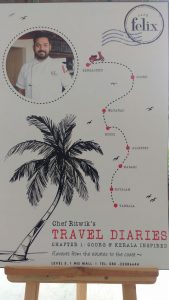
One of the things I cherish when I travel is the local food I find there. Many of you may do the same. This is one of the reasons we are increasingly seeking out homestays and smaller guest houses, preferring to give the regular hotels a miss.
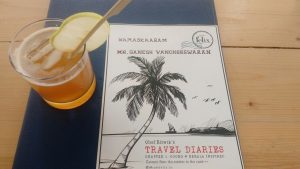
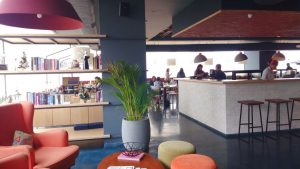
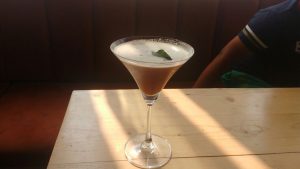

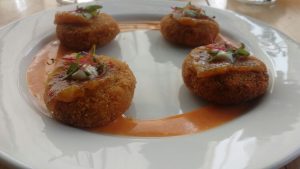
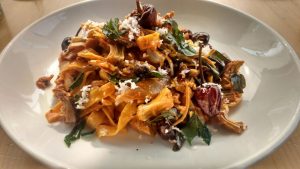
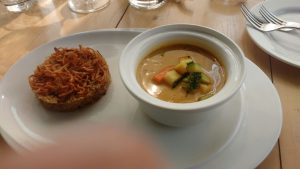
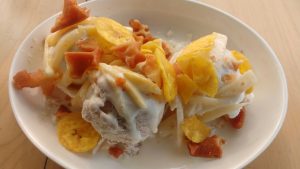

One of the things I cherish when I travel is the local food I find there. Many of you may do the same. This is one of the reasons we are increasingly seeking out homestays and smaller guest houses, preferring to give the regular hotels a miss.








About 15 kms south of Udupi (on the way to Mangalore) lies a delightful strip of sand and surf called Kapu.
______________________________________________________________________________
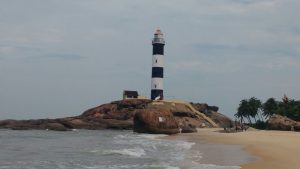
I had come to Udupi to meet my nephew, who studies at the Manipal Institute of Technology. One morning during my two-day stay there, I found myself free. My nephew would be in class till the afternoon, after which he would meet me. On a sudden whim, I decided to visit one of the beaches dotting the beautiful coastline of Dakshin Kannada (meaning, South Karnataka). After some serious thought (because there is an overdose of options), I plumped for Kapu beach (some locals call it Kaap). Kapu was most convenient for a half-day trip, because it is situated just 15 kms from the town of Udupi where I was shacked up. Buses were frequent. I could visit the beach and be back in time to meet my nephew.
After a breakfast of medu vada and dosa, accompanied by coconut chutney and sambar, I boarded an ‘express’ bus to Mangalore. Unlike regular buses, express buses take the highway to Mangalore and do not get into country roads. They are therefore much faster than their ordinary cousins. About 25 minutes later, I was deposited at the Kapu junction on the same highway. The ticket cost me all of Rs. 18. On the way, I was treated to delightful vistas of coconut palms and arecanut trees, old-style houses with brown tiled roofs, ponds and lagoons and small shops lining the highway. The landscape here is very similar to that of Kerala, since Dakshin Kannada lies just north of Kerala along the same coastline. Even the cuisine (especially the seafood dishes) are prepared and eaten the same way as in Kerala.
Disembarking from the bus at Kapu junction, I took an auto to Kapu beach. The ride cost me Rs. 30/- . Autos have fixed fares from the junction to different places in the area. Bargaining is not of much use, since the auto drivers operate as a union. Passing through shaded country roads with houses on either side (and even the odd motor garage), I reached the beach in 5 minutes.
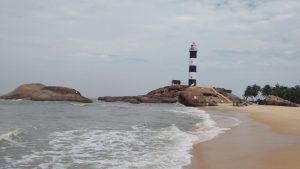
Standing at the entrance to the beach, I took in the entire stretch in one glance. Close by to my right at one end of the beach stood the lighthouse, a somewhat grim and lonely apparition rising into the sky. To my left, the sandy strip curved a long way until it ran into a clump of boulders that marked the other end of the beach. A concrete pathway had been built along the inner edge of the beach and stone benches had been built along this. Through the intense haze of the summer morning, I could see that the beach was deserted. There must have been just a dozen people scattered along its entire length. Some of them were lounging on the benches in the shade of coconut trees (understandable, given the heat), but surprisingly, some other were frolicking in the rushing waters. But then, I remembered that while even during the height of summer, the sea water is cool.
After standing in the water myself for a few minutes, I started walking towards the lighthouse. At some distance into the sea, I could see a lone fishing boat bobbing in the waves. This fisherman must have come late to the fishing party, I speculate idly. Or maybe, he just had a refreshing beer and gone off to sleep. The instant this thought flashed through my mind, I yearned for a bottle of cold beer myself. My thirst for beer was so bad in that instant, that the hair on my arms bristled and I could clearly feel the parched bottom of my throat.
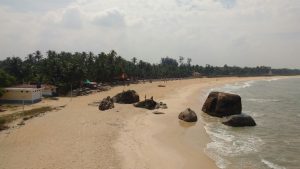
I had to climb up three flights of stairs to reach the base of the lighthouse (because it was perched on top of a boulder). I saw to my disappointment that it was closed. I could not spot the caretaker either. It wondered if it is an abandoned lighthouse. Or maybe it would open only at night, when ships and boats had to be guided. Climbing to the top of lighthouses and gazing out in all directions is something I love doing. I have done it in several places, like Chennai, Kannur and Daman.
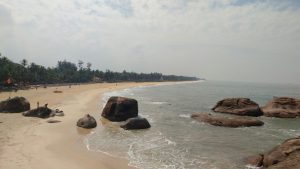
Not finding anybody to ask, I plonked myself down in the shade of the tall structure. This vantage point gave me a different perspective of the whole area. To my right, I saw another beach stretching out into the distance. A few fishing boats were parked on the sand and a few mesh nets spread out next to them. The fishermen will claim them again before dawn the next day, when they put out to sea in search of fish. On another side, a shallow stretch of backwater flowed past to form a lagoon. Far away into the sea, I could make out a few dots. I assumed them to be cruise or cargo ships. The breeze was mild. It was all very peaceful and life seemed very good from my perch. It seemed better still, when, a moment later, I remembered that I was lazing on a beach on a weekday.
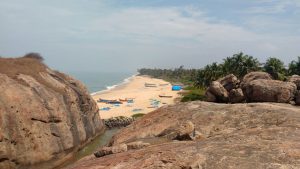
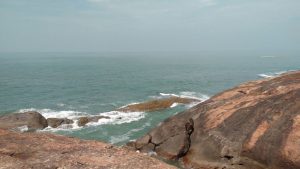
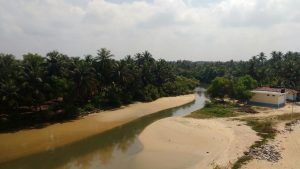
I did want to get into the water and splash around a bit, but the sun was too harsh for that. Instead, I had a super-refreshing tender coconut and caught a bus back to Udupi.
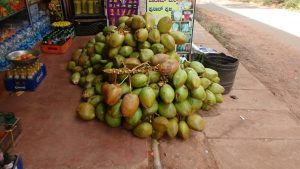
I am going to return to the Udupi belt during the monsoon this year, when this whole belt will be lush and wet. I just can’t for that.
The vitals
________________________________________________________________________________
Though few people know this, the northern part of Kerala has as much to offer a traveler as its southern counterpart. Ask anybody about Kerala, and you are likely to hear about its backwaters and houseboats, its swaying palms, its beaches (especially Kovalam) and the dance form of Kathakali. Someone slightly more knowledgeable about the place would probably tell you about Fort Kochi and its old-world ambience (including Jew Street, which is the last remnant of a once-strong sub-culture of Kerala), the Ona Sadya (a traditional feast served during the festival of Onam) and the annual boat races of Alleppey. Over the years however, few visitors to Kerala have bothered to look at what lies North of Kochi.
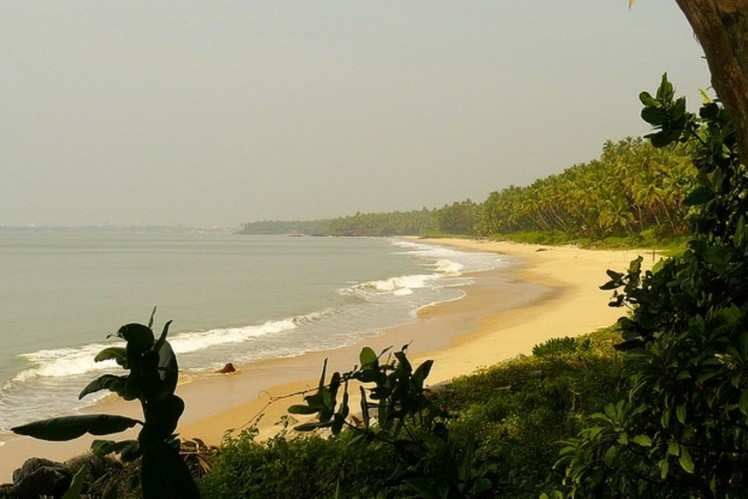 Photo by: Sandeep Gangadharan, Creative Commons Attribution Licence
Photo by: Sandeep Gangadharan, Creative Commons Attribution LicenceYou’d be amazed at all Malabar has to offer—mountains, rivers, untouched beaches, forts, old-world towns, bazaars, museums, temples—there’s something here for everyone. Malabar is the region that starts from Malappuram (just north of Palakkad) and stretches right up to the northern-most tip of Kerala. A princely state till 1956, this is where Vasco da Gama first set foot in India in the 15th century, thereby laying the foundation for the globalisation of Kerala. Through the centuries, commerce has always flourished in the region, but when it comes to tourism, Malabar has always eluded tourists. The next time you think of visiting Kerala, add Malabar to your itinerary, and you’ll come away charmed.
Kannur
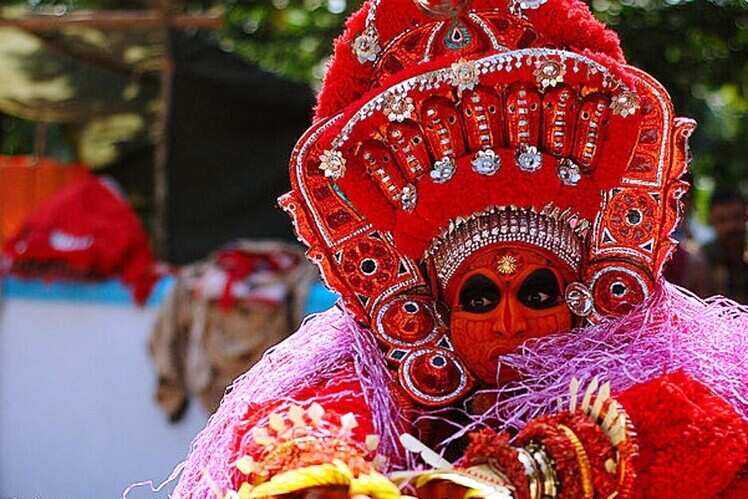 Photo by: freebird (bobinson|ബോബിന്സണ്), Creative Commons Attribution Licence
Photo by: freebird (bobinson|ബോബിന്സണ്), Creative Commons Attribution LicenceKannur was the seat of the Kolathiri rajas and the Arakkal dynasty. The main attractions here are its beautiful beaches, temples dedicated to Muthappan (Lord Shiva in his incarnation as a hunter) and the enthralling dance form of theyyam. Angelo Fort, a couple of kilometers from the centre of town, is a legacy of Kannur’s earliest foreign settlers, the Portuguese. The sprawling fort is rather well-maintained and offers a stunning view of the sea from its ramparts. Out of the beaches, the beaches of Muzhappilangad and Thottada are secluded and definitely worth a visit. Visit a handloom weaving centre for some great bargains, and if you’re culturally inclined, take in a theyyam dance performance at a local Muthappan kaavu. Round off your stay in Kannur with a visit to the Arakkal Museum, which is a repository of royal possessions from the days of the Arakkal Dynasty.
Kozhikode
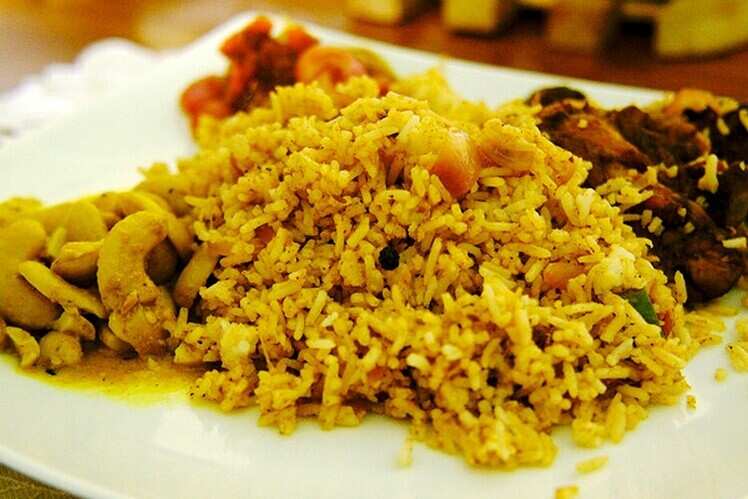 Photo by: Shehal Joseph, Creative Commons Attribution Licence
Photo by: Shehal Joseph, Creative Commons Attribution LicenceFor most tourists, Kozhikode is a jump-off point on the way to Wayanad, or a snacking halt during the long haul over the mountains to Mysore or Bangalore. But pause a while and look around, and you will see that Kozhikode throws up a mélange of flavours. For centuries, it has been the bustling capital of commerce in Malabar, and is one of the oldest ports in Kerala. The older sections of the city are known for their bazaars and wholesale markets—you can buy a bewildering variety of spices here at extremely reasonable prices—and the city is dotted with beaches like the Kappad beach (the exact spot where Vasco Da Gama landed in Kerala), Kozhikode beach and Payyoli beach. When you have had your fill of the sea, head over to the bountiful hills for a dose of trekking and a bath in the Tusharagiri Falls. Sightseeing aside, Kozhikode is a great place for foodies—head to Hotel Paragon on Kannur Road for some excellent Malabar biryani, appam and kadala curry—and indulge your sweet tooth with some delicious Kozhikode halwa.
Bekal Fort
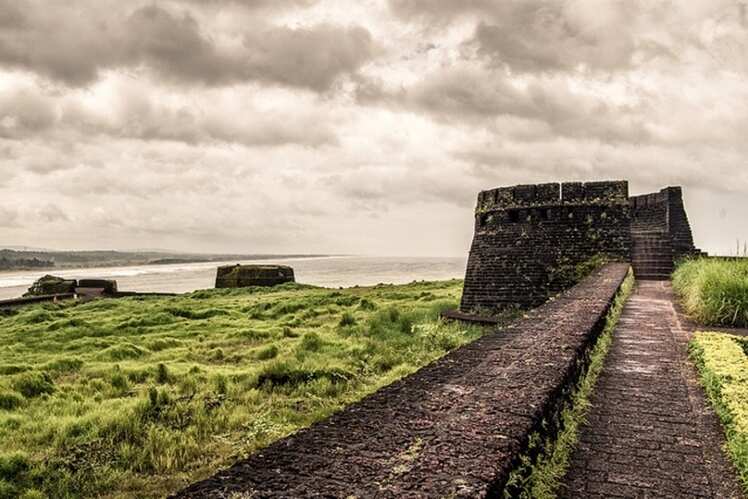 Photo by: Renjith Sasidharan, Creative Commons Attribution Licence
Photo by: Renjith Sasidharan, Creative Commons Attribution LicenceBetween the towns of Kannur and Kasaragod lies Bekal Fort. Around 300 years old, it looks like a giant key-hole when seen from above. Abutting the Arabian Sea, it stands like a proud sentinel—which indeed it was in the olden days—guarding the city from marauders approaching from the sea. Thankfully, it has been well-preserved, and exudes oodles of atmosphere. You can see the tall observation towers, from where huge cannons used to be fired during battles.
Nilambur
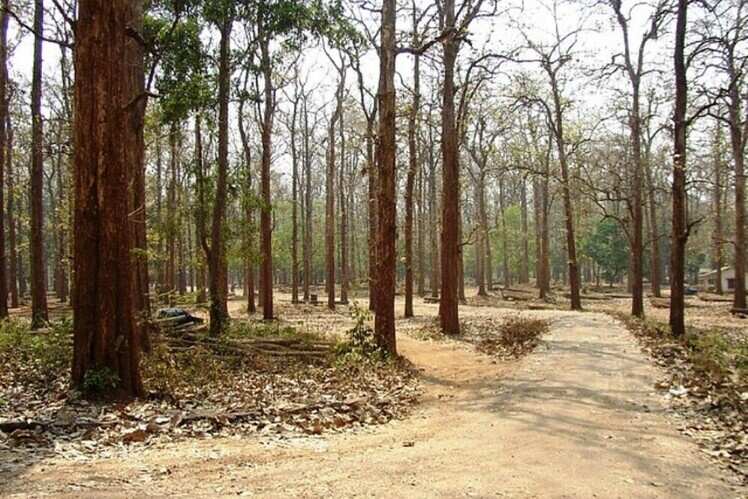 Photo by: Dhruvaraj S, Creative Commons Attribution Licence
Photo by: Dhruvaraj S, Creative Commons Attribution LicenceNilambur is practically hidden from the eyes of the world. Situated off the trunk route, it is a charming little town with an undulating terrain. Though its tree cover has reduced over the decades, it is still green enough to send you into a trance. Teak plantations abound, and so do old mansions. You can find the oldest teak plantation in the world—called Conolly’s plot—here, and there’s even a teak museum on the premises. In Keralan history, Nilambur has always been known for its kovilakams (stately manors that were once the residences of princely families of yore). Built according to traditional norms of architecture, kovilakams are beautiful structures of wood and laterite, with inner courtyards, intricate etchings on the ceilings, and extensive slat work. The forests of Nilambur are home to a number of elephants, and trekking along the elephant corridors is a delight. There’s a large variety of accommodation to choose from, although you should plump for the homestays—which offer a good combination of beautiful architecture, old-world hospitality, solitude and good food.
A town that becomes a canvas for artists.
This story first appeared in Mint on January 19, 2017 under the section ‘Weekend Vacations’.
____________________________________________________________________________

Aspinwall House
Fort Kochi is not a place you visit just once in a lifetime. This former Portuguese and Dutch colony offers experiences at multiple levels, inviting you to find meaning and solace time and again. And for those who love a dose of history and culture by the seaside, this is a great bet. Which is perhaps why, when I wondered about an ideal solo travel destination for the weekend, Fort Kochi automatically came to mind. Especially since the art festival, Kochi-Muziris Biennale, was back in town.
An overnight train journey from Chennai took me to Ernakulam. There, I hopped on to the ferry across the backwater channel that lies on the fringes of the city. Ernakulam (also known as Kochi) is the main city and commercial hub. Lying close to the mainland, but joined by bridges, are the small islands of Willingdon (mostly government offices), Fort Kochi and Mattancherry (the travel hub), Bolgatty and Vypeen. The boat took me past leafy Willingdon Island, busy Thoppumpady and medieval Mattancherry, before dropping me off at Fort Kochi. The shimmering waters, the local people and the fishing boats bobbing up and down the gentle waves kept me company. What an atmospheric journey for just Rs. 4!

Dumping my bag in my room, I had a quick shower and headed out. Hunger pangs led me straight to Kayees (also known as the Rahmathulla restaurant). Several decades old, this simple eatery has been a favourite for a Kerala breakfast. After a few appams (rice pancakes), idiyappams (rice noodles), kadala (chickpea) curry and a cup of strong tea later, I found myself at Aspinwall House on Calvathy Road. This is the main venue of the ongoing Kochi-Muziris Biennale, an art festival that is held once in two years (Kochimuzirisbiennale.org). Into its third edition this year, the biennale, which began on 12 December, is on till 29 March.
The decision to revisit this festival was an inspired one. Unlike most art shows, the biennale does not take place in an air-conditioned hotel or a posh gallery. Instead, it takes place all over the township—in old spice and timber yards, local art galleries, and mansions that are two-three centuries old.

All day, I moved from venue to venue, studying the stunning paintings, etchings and installations on display. In this, my fourth visit to Fort Kochi, I felt like I was seeing the town for the first time. I took in Brij Mohan Anand’s dissentive art at the Greenix Village cultural arts centre and the brilliant paintings on the history of immigrant Jews at the Kashi Art Gallery. Elsewhere, I found exquisite cloth tapestries created by cutting old clothes and re-stitching them. I was told by another visitor that several local tailors had been involved in this project. The day ended with stimulating INK Salon talks at Cabral Yard.
The next morning, I strolled through Jew Town in the satellite area of Mattancherry. With its cobblestone streets, timber-framed houses and a 16th century synagogue, it evoked a different, historical era. Shops selling authentic antiquities vied for space with those selling spices, essential oils, tea and handmade soaps. At a store called Crafters, I found what must surely have been one of the largest vaarpus (a traditional Kerala brass vessel used to cook at feasts) in the world.
By afternoon, my feet gave up and I headed to the Seagull restaurant. I sat on the deck abutting the estuary and sipped my drink. Waves lapped at the deck, seagulls glided silently and a balmy breeze caressed my face. A mammoth ship hooted as it passed close to the shore.
I sighed in contentment.
Learning about seafaring traditions, playing on the beach, and visiting a fort built by the Portuguese.
This story first appeared in Mint on July 27, 2017 under the section ‘Weekend Vacations’.
_______________________________________________________________________________

Fisherfolk unloading the catch of the day at Thottada beach.
The lady bore a striking resemblance to my grandmother. Her gaze was benign, and she seemed to be smiling. I almost smiled back, and then, remembering who she really was, I chuckled. For behind the gentle gaze was the hardy queen of the Arakkal dynasty. She came from a long line of rulers of the erstwhile Cannanore (now Kannur) principality. Rani Mariyumma Beebi Ali Adi Rajah, known as “Arakkal Beebi”, had inspired respect and admiration for the way she administered her principality in the year leading up to independence. And here she was, gazing at me from her photograph on the wall.
I was winding up a fascinating morning at the Arakkal Museum in Kannur in north Kerala. The Durbar Hall of the Arakkal rulers has been converted into a well-kept archive of their legacy. The two-storey building showcases solid teakwood furniture, weaponry, sepia-tinted photographs, evocative illustrations of ships, battle scenes, scenes from everyday life, and beautifully engraved ceramic-ware. Yellowed copies of letters that the royals had exchanged with the British threw up a surprise; the Laccadive Islands (part of the Lakshadweep Islands) had once been under Arakkal rule—the islands had been sold to the British.

Leaving the museum, I headed back to the Blue Mermaid Homestay, where I was staying, for a traditional Kerala meal. Come evening, I headed to the unspoilt Thottada beach, which is just next to the home-stay. Jogging barefoot on the sand, playing beach volleyball with a bunch of local boys and watching a glorious sunset stilled all thoughts, making for a contemplative end to the day.

On the next day’s schedule was a visit to Fort St Angelo, in the centre of town. It’s among the first forts built by the Portuguese in India, in the early 16th century. The stone and laterite fort has aged well. A thick layer of moss covering the walls and rampart was affirmation of a lavish monsoon. The barracks, magazine room, dungeons, bastions and chapel bear testimony to the fact that the Dutch and British had a hand in modifying the fort in later years.
My eyes were drawn to the mast of an old lighthouse that stands on one of the ramparts. The tourist policeman there offered an intriguing titbit: Francisco de Almeida, the first Portuguese viceroy to India, had kept his anointed successor, Afonso de Albuquerque, imprisoned in a dungeon in the fort, until he was ordered by his superiors to free him.

The western corner of the rampart offered a view of slim, colourful fishing boats with seagulls perched on the bows, at the edge of the waters. The sun glinted off the sea, casting a magical light. It was a scene straight out of a painting. This was Moplah Bay, a bustling port-of-call for Chinese, Arab and European traders in ancient times.
The next stop was MVK, the town’s go-to restaurant with an impressive list of local dishes, for delicious Thalassery biryani.
I spent the afternoon at the lighthouse museum. One of only four in India, the museum provides a rare insight into Kannur’s long seafaring traditions. It unveiled everything I ever wanted to know about lighthouses: from lamps, models of primitive lighthouses, navigational buoys and electromechanical parts to letters written by mariners. What’s more, there were no tourists—and I felt vindicated in my choice of an offbeat weekend break.
Fort Kochi, the most interesting part of Kochi city in central Kerala, deserves your attention. To me, it is one of the most interesting parts of Kerala, infinitely more interesting than Ernakulam, its cousin across the bay. Ernakulam is your regular Indian city, forever caught in an urban tizzy. It has lost much of its cultural identity and sanity over the past two decades.
Fort Kochi, on the other hand, is a different world; an oasis of cultural and historical riches that soothe the soul of the discerning traveler. Here, you will find a co-mingling of several histories, because a number of dynasties and communities have left their imprint on this tiny piece of land.
For many centuries, Kochi was ruled by several native Malayali chieftains and kings. It is a documented fact that Kochi state was formed in 1142 AD, when the kingdom of the erstwhile ruler Kulasekhara, broke up. Not much is however known about this kingdom until the late fifteenth century, when Vasco da Gama landed on the coast of Calicut.
Fort Kochi came into existence only after the arrival of the Portuguese in India. A few years after they made landfall on the Calicut coastin 1498, they ventured south and built a settlement on a land parcel gifted to them by the then king of Kochi. Their interests lay mainly in trade. They were keen to ship back pepper and other spices. Soon after they reached Kochi, they fortified it with permission from the Kochi Raja and named it Fort Emmanuel. When the modern city of Kochi was formed much, much later, Fort Emmanuel was renamed Fort Kochi. Except for a bastion and a cannon (which you’d be hard put to find), nothing remains of the fort today. But the town has emerged into a vibrant tourist destination.
I give you five specific reasons why you should go there right away.
One: the Portuguese heritage and the churches
The Portuguese were aggressive conquistadors. At the same time, they were prolific builders too. Wherever they went, they put up all manner of beautiful structures – including stately mansions, churches and forts. Fort Kochi is a superb example of the architectural legacy of the Portuguese.
I love two things the most. The first is the way in which they beautifully blended Portuguese and European sensibilities with the native Keralan architectural style. And so, you will find tall columns, arches and gables in houses that are roofed with local tiles. And since no house in Kerala is deemed complete without a backyard and a well, you will find a lush backyard and a deep well too.
Stroll along the streets of Fort Kochi and you will see what I mean. Several of these buildings have been converted into cafes, art galleries and guest houses, which is great. It means that tourism is being built on the strong foundation of a heritage conserved. Bishop’s House, Cabral Yard, Bastian Bungalow and several hotels around the Vasco da Gama Square are fine examples of Indo-Portuguese architecture.
The other thing I love about the Portuguese are their churches. Here, you will find solid masonry, tall spires and belfrys, exquisite stained glass, unshakeable wooden furniture and beautiful murals and frescoes.
Fort Kochi has the best collection of medieval churches in India, all within a few miles of one another. From the church where Vasco da Gama was first interred after his death (St. Francis Church, 1516 AD) to Santa Cruz Basilica (1505 AD), Our Lady of Life Church (1650 AD), Our Lady of Hope Church (Vypin, 1605 AD) are some of the best churches I have been to. It is a pleasure to sit in the pews in silence for a bit, then gaze up at the murals, take in the liturgical furniture and finally, stroll around in the church yard. I get goosebumps when I find tombstones dating back to the sixteenth and seventeenth centuries.
Speaking of churches, Fort Kochi has one of the most intriguing museums I have ever seen. The Indo-Portuguese Museum is located inside the compound of Bishop House and contains a number of rare artefacts from the Portuguese era. With one important twist: these artefacts are all liturgical in nature; which means, they pertain to the history of the Catholic Church in India. From medieval versions of the Bible, chalices, crosses, altars and vestments, they are all on display here. If you love love the intersection of history and religion, you will love this museum for sure.
Two: the beaches
Fort Kochi is located bang by the sea. It is home to a few lovely beaches where the sand is golden brown and very clean. Apart from what is known as the Fort Kochi beach, there is a beach in Vypin and another in Cherai. Fort Kochi beach does get crowded in the evening, but you can still have a lot of fun. The crowd is never troublesome. Cherai and Vypin beaches are lesser known and therefore, much less crowded. You have to be very careful though, because the waters are very rough. We have built sand castles, jogged on the wet sand and played Frisbee here.
Being on the West coast, these beaches give you great views of sunset. Finish frolicking in the water by 5:30 pm or so, and then settle down on the sands. Watch the sun slowly sink into the horizon. The orange and pink glow it casts on the waters is magical indeed! Words have no place at moments like these. I love basking in this fading glow. At times like this, I truly feel one with the universe.
Three: the food and the restaurants
Where there is the sea, there is bound to be excellent seafood. And so it is with Fort Kochi. Eateries here offer you a wide variety of fish, in addition to prawns, squids and crabs. And you can have them fried or curried, cooked in one of several ways in the traditional Kerala style.Pair these dishes with the flaky, crisp Kerala porotta or dosaiand you will reach heaven in this life itself.
Or, you could order a naadan (‘country/local/traditional’ in Malayalam) meal, which is served on a plantain leaf, and ask for a non-vegetarian dish on the side. The meal, known as ‘oonu’ in Malayalam, typically consists of two or three vegetable preparations (such as avial, thoran, kaalan, etc.), sambar, rasam, spiced buttermilk, papad, banana chips and pickle, all this to be eaten with nutrient-rich parboiled rice. Some restaurants add a few other items to this ensemble.
My preferred place for lunch or dinner is a sea-fronting restaurant with excellent views of the harbor and the bay. To eat and drink while watching boats and mammoth ships pass by is an interesting experience, to say the least. Seagull Restaurant on Calvathy Road is my all-time favourite for a beer and meal.
For breakfast, stick to delicious local food options like puttu, appam and dosai, served with kadala curry, meen curry or vegetable stew. My kind of breakfast is eaten steaming hot at a street cart, with the aroma of the food mingling with the chatter of locals who are digging in before plunging into their workday.I love to end the meal with a cup of strong Kerala style tea.
Though some eateries serve Continental food and noodles too, I give these a wide berth, because they don’t make it well. It just seems to be a pretence to serve foreign tourists.
Four: the atmospheric hotels
Nowhere else (at least in India) have I seen so many lovely, centuries-old buildings that have been converted into hotels, B&Bs and guest houses. And each one of these buildings has many tales to tell. Koder House, for instance, belonged to a Jewish family in the 19th century, before it was sold by the last descendent. It is now the lovely hotel with a red façade on Vasco da Gama Square. Old Lighthouse Bristow Hotel was the site of the old lighthouse of Kochi and the residence of a senior official of the British empire. The Old HarbourHotel belonged to the Dutch way back in the eighteenth century. I could go on like this.
These hotels are high on history and atmosphere, something you’d not find in a regular hotel.
Five: the native art forms of Kerala
Take in a cultural performance at the Kerala Kathakali Centre, located in a tiny winding lane near the Santa Cruz Basilica. A few months back, I spent an enchanting evening watching a Kalaripayittu performance, an ancient martial art form of Kerala. The Centre hosts vocal and instrumental concerts and Kathakali recitals also.
Another venue for such performances is Greenix, which has two auditoria. One of them is located near the bus stand and across from the boarding point for the ferries to Vypin (don’t ask me why, but these ferries are called ‘Jhankar’). Greenix’s second centre is located onCalvathy Road, near a landmark building called Pepper House.
When you are there….
The vitals
Getting there: Fly to Kochi International Airport and take a taxi to Fort Kochi from there. Or, take a train to Ernakulam from wherever you live. From Ernakulam, take an auto or a bus for an overland ride to Fort Kochi. A more interesting way, however, is to take an auto to the Ernakulam boat jetty and hop onto a public ferry from there.
Shacking up: Like I mentioned earlier, Fort Kochi doesn’t want for accommodation options. From backpacking hostels to luxury hotels, you will find everything here. I think the most interesting way of experiencing the place is to plump for a seaside luxury hotel (high priced, obviously) or a homestay (mid-priced). The Old Lighthouse Bristow Hotel is one of the best luxury hotels I have stayed at. A sea-facing restaurant, an al-fresco lounge, a swimming pool and lovely old-fashioned rooms make this a charming place. The food and service are very good too (in particular, the enormous breakfast that is part of the room tariff).
From many forays to Fort Kochi though, I know that the following are also excellent options:
Koder House(luxury; not seaside, but near the sea and the Chinese fishing nets)
The Cochin Club (mid-priced, but very comfortable and almost luxurious)
Tower House Hotel (luxury; not seaside but near the sea and the Chinese fishing nets)
Brunton Boatyard Hotel (luxury, seaside)
Vintage Inn (at Jnaliparambu Junction; low-priced, but clean and comfortable)
Happy Camper (at Jnaliparambu Junction; a backpacker’s hostel)
Grub
Here is some more dope, beyond what I have told you above. A couple of my favourite eateries here are:
Seagull: seaside restaurant and bar, best known for its Kerala style food. Try to go at around 5:30 pm and catch a table on the re-purposed boat pier. Sit back for the next few hours and watch myriad interesting sights as you guzzle cold beer and enjoy your food. It is not everyday that you get to have a beer watching a glorious sunset or a mother of a ship pass close by.
Shanu’s food cart: This is where you should go, for a cheap, authentic, delicious local-style breakfast. The cart is permanently stationed adjacent to the Tower House Hotel on Vasco da Gama Square. You will invariably find a crowd here from say 6 am every morning. Gorge on puttu, appam, kadala curry and meencurry. Once you reach the Square, ask a local to direct you to Shanu’s thattukada (‘thattukada’ is Malayalam for food cart).
Getting around
This settlement is small enough (and of course beautiful enough) to cover on foot. This is how I move around whenever I am there. Other good option is to hire a cycle or scooter by the day. Auto rickshaws (known as tuktuks in certain countries) are available too.
Since Kerala is a conservative state, please cover up adequately.Since the weather is extremely hot and humid for six months a year, light, summery clothes would be your best bet.
With the influx of foreign tourists, some local eateries/bars.auto drivers have started acting snooty towards Indian tourists. Which is sad. I have encountered such specimens a few times. So, if you are an Indian visiting this place, be warned. Remember to not take it personally. If you find someone behaving unreasonably, just give him a piece of your mind (politely, but firmly) and move on to another auto, eatery, hotel. There are plenty of options.
When to go
The heat here is torrid from March to June. If you go during these months, you can roam around in the morning and evening, and retreat to your room in the afternoon.
The best time is from mid-June to mid-August (when the place is drenched by the monsoon rains) and from November to February (when the weather is somewhat pleasant).
Picture this. A British engineer is brought to India from London, on the express commission of building the Cochin port. This man accomplishes this task with the help of a large team that includes native Indians. Over the years, he makes Cochin a port to reckon with. With the arrival of the port, the railways too came to the area (the imported goods had to be carted away from the port, right?), and the Cochin Harbour Terminus was established in neighbouring Willingdon Island. The engineer is lauded by none less than Lord Willingdon, the then Governor of Madras and is decorated by the Queen.
In 1928, this man, who answers to the name, Robert Bristow, builds a sprawling mansion for himself by the sea and lives there until his return to Britain in 1941. The parcel of land he picks offers choice views of the untamed sea, of boats and ships passing by and of glorious sunrises and sunsets. But it has something more than all this too – a piece of maritime history. Because on this very same plot of land stood the old Cochin lighthouse, the guiding lamp for ships passing through the bay.
Fast forward by ninety years. The bungalow by the sea is now the Old Lighthouse Bristow Hotel, a boutique hotel. A couple of sit-outs with awnings, a lawn, a swimming pool and two rooms have been added to the compound. Modern fixtures have been fitted too. But the core of the mansion remains as it was all those years ago. The wooden floors and stairs, the large wood-framed windows, solid wooden doors and tiled roofs are all there and in superb nick.
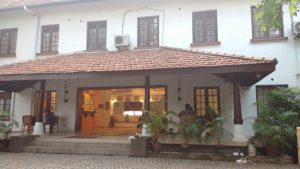
We stayed at this hotel for three days recently. We were treating ourselves on the tenth anniversary of our hitched life. Sitting on the terrace that gives on to the sea, I remember thinking that ‘hitched’ would be a wrong word to describe our married life. On the contrary, ‘liberated’ would be the apt word, because I found my soul mate in my wife. Someone who shares my love for life and believes in letting me live the way I want to, rather than imposing ifs and buts on me. I really started leading an unfettered life only after I came to know her.
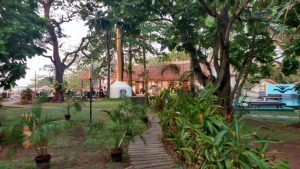
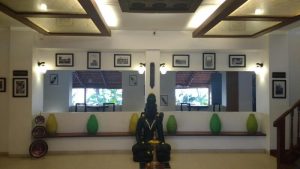
We are given the only room in the hotel that has a private terrace. I look at the nameplate outside the room (The Bristow Suite) and realize that this is the same room that Robert Bristow used to occupy all those years ago. Apart from the terrace, the suite has a spacious room and a roomy bathroom. Most of the furniture has an antique look, right down to the brass dial telephone in which the earpiece and mouthpiece are different. This instrument is the source of much excitement to us over the three days, with each one of us taking turns to make calls on it. If the hotel staff are surprised to find so many calls coming from our room, they do not show it.
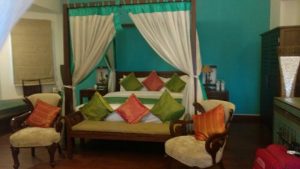
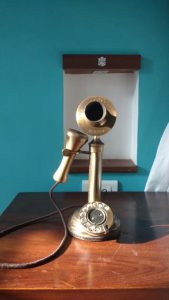
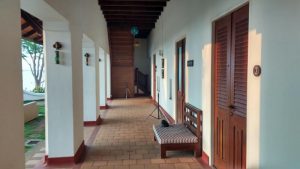
Our typical day was like this. We wake up at about seven and settle down in the terrace with a cup of tea to watch the sky come alive. The sea breeze caresses our faces as we drink in the sights and sounds. On the tiny beach next door, people are already riding the waves. Our cuppa over, we head over to the beach for our own share of frolicking. An hour later, we tramp back to the hotel, totally drenched and with sand all over. A large grin is plastered on our faces. We wash off the sand (but not the grin) at the outdoor shower, change clothes quickly in our room and come down for some much-needed food.
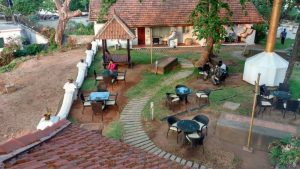
Breakfast is sumptuous, with a few Continental and Indian dishes on the menu. Apart from cornflakes, fruits, a variety of fresh juices, toast and eggs, there are a few Keralan dishes on offer. We see a changing menu of dosas, idlis, uppuma, puttu and appams, with chutney, sambar, vegetable stew, kadala curry and peas curry to go with them. Over the next hour and a half, there is total silence at our table, as we treat the food with the devotion it deserves. Sitting back with a belch and a contented sigh, we move on to a cup of hot South Indian filter coffee. In between all this, we chat with the genial wait staff, gleaning details about their life, the hotel, the town and sundry other things. They are hardworking people who help a lot in giving us a great experience.
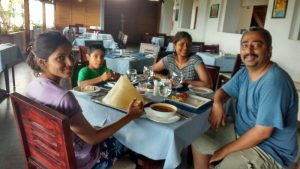
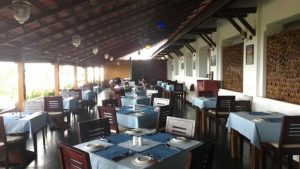
We then drag ourselves out of the hotel for a bit of exploration. If we take in the little-known Indo-Portuguese Museum and the St. Francis Church one day, we visit the Vasco da Gama Square and the quaint little streets around it the next. One morning, we take off to explore Vypeen island and the beach in the tiny hamlet of Cherai (separate pieces on all this to come soon on the blog). Later, we down a beer somewhere and lunch at a sidewalk café or a thattu kada (mobile food vending stalls that serve authentic local food in Kerala) before returning to the hotel for a snooze.
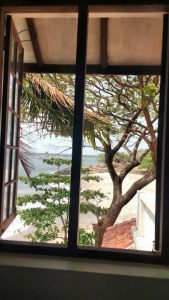
Late afternoon finds us in the lovely pool, letting the water cool down our heated bodies. Afterwards, we lie back on the deck chairs and read awhile.
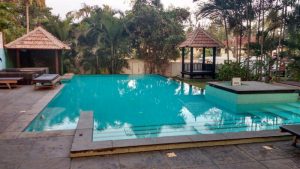
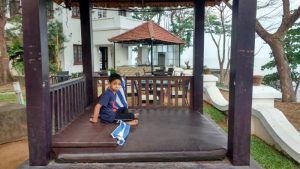
Come evening, we take a table on the sea-facing lawn and gaze out at the churning waters. Over the three days, we got used to seeing boats big and small, and ships so massive, your jaw’d drop. Some banter with fellow-guests follows. And soon, the great orange disc in the sky starts dipping towards the sea. There are few sights in the whole world that rival a sunset in sheer beauty and simplicity. Even a sunrise pales in comparison, I think. Words seem not just out of place, but positively intrusive at this time. A cloak of silence invariably descends, as all the guests and even the hotel staff submit to the mesmeric beauty of the moment. Slowly, we watch the fireball inch its way towards the great waters on the horizon. And then, finally, it touches the sea and melts into it.
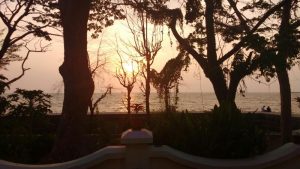
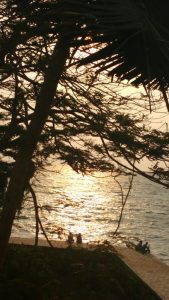
We wend our way to our room and take our place on the terrace. Uncorking the bottles, we sit down to enjoy a few drinks. Sometimes, we talk. At other times, we fall silent. The mind wanders into fresh pastures. A pleasurable hour or so later, it is time for dinner. We choose one of the lovely cafes that are housed in bungalows nearby. Bungalows that are at least two hundred years old; some built during the Portuguese rule, some during the British time. In all of them, you can see colonial architectural influences beautifully merging with the native style of Kerala.
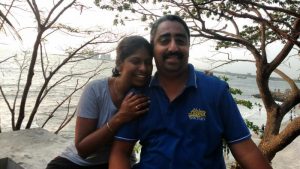
Returning to the hotel, we read or star-gaze on the terrace. A few guests are dining on the lawn below, their conversation punctuating the silence. Gradually, the neighbourhood falls silent. The diners go back to their rooms. The last revellers leave the beach and go home. After that, it is just the sea, the breeze, the swaying trees, the moon, the stars and us. And then, late into the night, very, very reluctantly, we leave the terrace and get back into the cozy room. Tonight, will it be the four-poster queen-sized bed or the bay window that is wide enough and comfortable enough to sleep on?
As we hit the sack, there is a sense of peace and quiet satisfaction. It has been a wonderful day. Lazy, yet productive. And sooner than later, we surrender to blissful sleep. A glorious tomorrow awaits us.
_______________________________________________________________________________
P.S. I doff my hat to the management and staff at The Old Lighthouse Bristow Hotel for giving us a supremely memorable stay there. The room, the property, the food and the service were all first-rate.
We paid for the room and food. Our stay was not sponsored by the hotel or any other company/person.
Hotel fact file